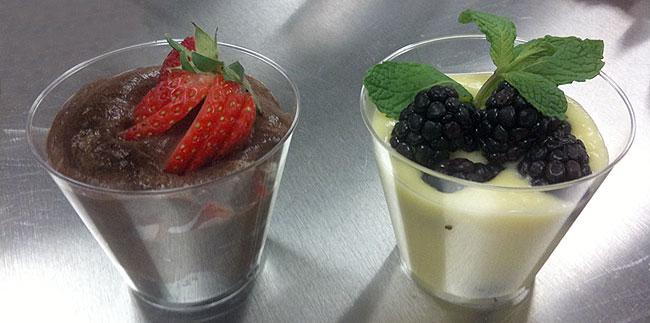This weeks class was a little different from previous classes. Rather than the focus being on the techniques used to produce a specific kind of finished product, the focus was on elements of products. Specifically, the class covered creams and mousses; we made a flavored mousse (used for piping into molds), classic chocolate mousse, lemon curd and pastry cream. I did not get a lot of pictures because we only took one finished product home, along with two creams in Tupperware. One product is still in the freezer waiting to be finished next week. I’ll update this post with the pictures of the piped mousse in a hazelnut biscuit next week.
Pastry Creams
Accurate measurements are very important, weigh the ingredients. When steeping the milk, do not boil it (loss of water via heat throws off the ratios). Do everything at the stove while the ingredients are hot. Always use a whisk and a stainless steel saucepan or your cream will turn gray or green. Sugar prolongs the reaction to the heat and milk. The hotter the temperature of the milk the faster your pastry cream with become thick (should not be too hot, if the recipe uses corn start it starts to thicken at 180°. Eggs in the recipe add to the creaminess of the the pastry cream.
Lemon Curd
If you don’t like zest in curds you can leave it out without affecting the flavor, its usually in it for texture. Cooked over a bain-marie (water bath) because of its delicate. You can replace the lemon with many different citrus fruits (limes, oranges, etc), just have to experiment with the amount to get the desired flavor.
Chocolate Mousse
Use the best chocolate you can afford. The warmer the egg whites the higher/more volume you get when they are whipped. Add the sugar at the right time (right after it turns to white foam). The colder the cream the high/more volume you will get when whipping it. Both egg whites and cream produce a better texture when you whip them using a slow speed, patience is key.
Flavored Mousses
Pasteurizing uncooked eggs by bringing their heat to 160° over a bain-marie (water bath). Mousses use either all cream, all egg whites or a combination of both. When making a mouse for molding don’t go past soft peaks on egg whites or you won’t be able to use the mixture in a mold (it will be too thick).
Blooming Gelatin
Bloom means to soften in water. There are two types of gelatin, sheets and powdered. Powdered is the most common in the US, sheets are popular in Europe and parts of Asia. When using gelatin as a thickener, too much will leave a mousse too firm, not enough it will make it too runny. Follow the recipe and weigh it if possible. When adding gelatin to a mousse it must be hot or it will cool too quickly and create lumps of gelatin.
When blooming powdered gelatin make sure to have a lot of surface area on the top of the water to properly absorb into the gelatin. Too small of an area will leave the gelatin only partially bloomed and unusable. Do not stir it, just sprinkle it over the top, if you stir with a spoon it will stick to your spoon.

1 Comment
The stenciled bisquit is the coolest technique I’ve learned so far. Can’t wait to try it at home.